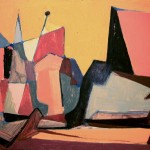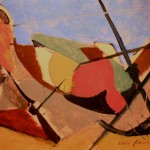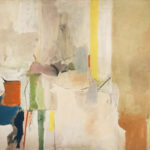Biography
Nicolas Carone (1917-2010)
A painter and sculptor whose style is non-objective, Carone was born in New York City to Italian parents who emigrated to New York where Carone was born on the East Side. When he was five years old, they moved to Hoboken, New Jersey where he spent the remainder of his childhood. His family remained in that home, which he later described as being like a salon with many art and music oriented guests. All of this activity was encouraged by his mother, but the father, a “stevedore”, had little interest in the discussions although he loved having the people around.
At age eleven, he began art study, attending the night school of the Leonardo da Vinci Art School. Also there but older than Carone were future well-known artists Isamu Noguchi, Peter Agostini, George Spaventa, and Conrad Marca-Relli. Carone was encouraged to study art by his parents, especially his mother who loved the Renaissance sculptors such as Michelangelo.
He had two brothers and three sisters, and his brother, Matthew Carone, became an artist in Florida, and his sister, Janice, became a concert pianist. He also studied music and played the violin for eight years. At age fourteen, he persuaded his parents that he should quit high school so that he could go to art school. He started attending the National Academy of Design where his teachers were Leon Kroll, Charles Curran and Saul Olinsky.
He also had a scholarship at the Art Students League with sculptor Arthur Lee. Leon Kroll was the artist he admired the most because he “was more liberal and modern. He had a very broad point of view. He was a big influence in my life, by the way. . .He was like a godfather.” (Cummings). He worked as an assistant to Kroll on a mural in Worcester, Massachusetts at the Worcester Memorial Auditorium. It was a dedication to the Unknown Soldier of the war of 1917. The project, 31 feet high and 57 feet long, took three and a half years, from 1939 to 1942.
He enlisted in the Air Force during World War II and was stationed in New York City and then Long Island and worked in drafting doing architectural drawings and table maps. During this time, he studied with Hans Hoffman, both at his New York School and at Provincetown. Although he did not like Hoffman’s Abstract Expressionist paintings, he admired him tremendously as a teacher, one of the reasons being that Hoffman was flexible and encouraged his students to find their own style. He also opened the door for Carone to many European modernist movements.
After the war, in 1945, Carone went to Rome, Italy for three and a half years. He had won the Prix de Rome Prize, which was given to him as a cash award. While in Italy, he was awarded a Fulbright Scholarship. In Italy, he formed close friendships with Mark Rothco, who had a studio next door to his and to Roberto Matta.
Returning to New York City, he worked at the Stable Gallery as an assistant and also exhibited his work. He divorced and remarried and lived in East Hampton on Long Island for about seven years, and then moved back to New York City. From the time of his return from Italy to New York, his own career of creating abstract sculpture and figurative painting took off. He had solo exhibitions at Frumkin Gallery, Stable Gallery, and Staempfli Gallery, and was in group exhibitions at the Museum of Modern Art in Rome, the Brussels World’s Fair, the Venice Biennale, the Tate Gallery, and the Geitain Group in Japan.
Additional awards were William Copley Grant and the Childe Hassam Grant from the American Academy of Arts and Letters. He taught at universities including Yale, Columbia, Brandeis, and Cornell, and at Cooper Union, School of Visual Arts, and Skowhegan School and was a founding faculty member of the New York Studio School, where he taught for more than 20 years.
Source:
Paul Cummings, Interview with Nicolas Carone, May 1968, Smithsonian Archives of American Art, Oral History
Peter Falk, “Who Was Who in American Art”

 Still Life
Still Life
 Untitled (Abstraction)
Untitled (Abstraction)
 Pincio
Pincio